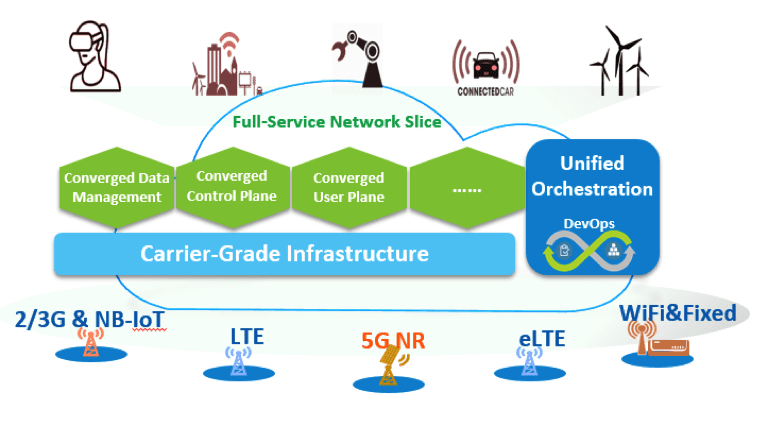Operators dilemma in the 5G era
After the introduction of 5G networks, legacy 2G/3G/4G networks will exist for a long time. When operators deploy new networks, they have to face many operation pain points of the 5G era caused by the long-term multi-network coexistence and handover.
- Multi-network correlation, impacting the rapid commercialization of 5G new services: Massive services need to apply to 2G/3G/4G/5G/Fixed networks, and service consistency is required for interoperation. To rapidly develop 5G new services, it requires legacy networks also being equipped with fast collaborative deployment capabilities.
- Complex networking for multi-network coexistence, causing high maintenance cost: The separated network architecture results in more network functions (NF) to maintain, complex NF interconnections, and high maintenance costs. The low interoperation efficiency across networks impacts user experiences.
- Selection and evolution of SA and NSA: At the early age of 5G, operators have to select the evolution path of SA or NSA according to their legacy network situation and investment budget. Even after the operators selects NSA, the network still needs to smoothly evolve to 5GC finally. Therefore, operators are hesitating in selecting SA or NSA.
- Evolution of legacy equipment: Massive devices of 2G/3G/4G/Fixed network are old or getting aged. Due to software and hardware binding, the performance, power consumption and footprint of these devices cannot be improved, and as spare parts are gradually out of production, maintenance and software upgrading becomes more and more difficult. New technologies are urgently needed to improve such situation.
ZTE Common Core is a 5G-oriented fully-convergent core network solution for all kinds of access systems of 2G/3G/4G/5G/Fixed networks.
This solution is constructed based on cloud native and 3GPP R15 SBA standards. It includes a convergent control plane, forwarding plane and user data, supports unified resource management, unified authentication and authorization, unified user experience and unified operation and maintenance, and aims to provide operators with efficient, open and intelligent new-generation networks. It helps operators achieve multi-network collaborative service deployment and network evolution in the 5G era, greatly reducing deployment and evolution costs.

ZTE Common Core has creatively introduced the following architecture technologies:
Introduce the 5GC architecture technology into 2G/3G/4G/Fixed networks: In the existing network, 5G new architecture and new features can be quickly applied with the introduction of service-based architecture (SBA), CUPS (control and user plane separation), stateless design, cloud native, AI (artificial intelligence) and other technologies..
Implement deep convergence of 2G/3G/4G/5G/Fixed networks based on NF and micro service components: this technology provides standalone and convergent networking capabilities of 2G/3G/EPC/5GC, and supports the fixed network accessing 5GC. Module sharing and automatic scale-in/out empowers ZTE Common Core with the rapid self-adaptive network resource scheduling capability.
Extend the capability exposure architecture to multi-network access: Extending the 4G/5G capability exposure architecture to 2G/3G/Fixed networks, the existing network access systems can also meet the capability exposure requirement of industry applications. The integrated capability development architecture provides a unified operational portal for third-party industry applications.
Value and benefits of Common Core
- For operators:
Reduction of total cost: Resource sharing and deep convergence save resource demands. User plane convergence reduces the consumption of forwarding resources. Simplified network topology and unified MANO management further optimize the management and prolong the lifecycle of existing 2G/3G/4G/Fixed networks, saving network management cost. This solution can save 50% of total cost.
Rapid deployment of multi-network new services: Cloud Native and other new features equip 2G/3G/4G/Fixed network with rapid service development and deployment capability in synchronization with 5GC. This solution improves the openness of existing networks, helping operators rapidly deploy new services.
Smooth evolution of network: During the network evolution with users migrating to 5G, the involved networks optimize resource allocation through automated load sharing and resource scale-in/out. With 5G capacity gradually grows, the capacity of legacy networks which are going to exit gradually decline. Thus, the network evolution completes smoothly.
Flexible 5G SA/NSA deployment: ZTE Common Core supports both 3GPP R15 SA and NSA modes, enabling operator flexibly to select SA, NSA or SA&NSA mode in one network.
Optimized FMC architecture: The centralized management of control plane simplifies operation and maintenance; the utilization rate of IP address and user plane disaster recovery resources is improved greatly; the fixed network and mobile network share the user plane, greatly saving forwarding resources and investments.
- For end-users:
Interoperation experience optimization: the interoperation handover duration is significantly shortened, bringing better service experience. For example, the call through latency of EPS Fallback voice is shortened.
Consistency experience optimization: when users access with different wireless access modes, they can enjoy better service consistency experiences.
- For industry partners:
Slice service: Providing services with network slices, to achieve on-demand customization of service and network, to meet a variety of vertical industries and application requirements in the 5G era.
Multi-network capability exposure: The unified capability exposure architecture for multiple networks simplifies the interoperation between industrial applications and operators’ networks, and explores the control capability of industrial applications on existing networks.
ZTE Common Core helps operators smoothly evolve to 5G, integrates vertical industries in depth, assists operators deploying future-oriented target network with multi-network convergence and services in one step with the fastest speed and the lowest cost, achieving the transformation from standalone network architecture to fully-convergent network architecture.

